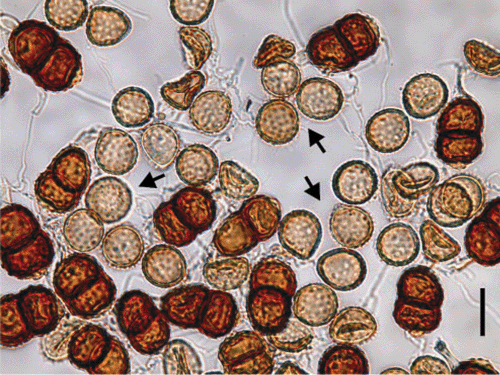Rust disease on sweet aromatic shrub Aloysia virgata in Brazil, caused by Prospodium paraguayense
A. L. Firmino A , D. B. Pinho A and O. L. Pereira A BA Departamento de Fitopatologia, Universidade Federal de Viçosa, 36570-000, Viçosa, MG, Brazil.
B Corresponding author. Email: oliparini@ufv.br
Australasian Plant Disease Notes 5(1) 37-38 https://doi.org/10.1071/DN10014
Submitted: 20 March 2010 Accepted: 8 April 2010 Published: 5 May 2010
Abstract
A rust disease caused by Prospodium paraguayense was observed on leaves of the sweet aromatic shrub Aloysia virgata collected in a fragment of Atlantic forest in the municipality of Viçosa, Minas Gerais, Brazil. This is the first record of Prospodium paraguayense on Aloysia virgata in Brazil.
Aloysia virgata (Ruiz & Pav.) Pers. (Verbenaceae) also known as ‘lixa’ or ‘lixeira’ is a large aromatic shrub found throughout the greater part of the Brazilian states of Bahia, Espírito Santo, Rio de Janeiro, Minas Gerais, Mato Grosso do Sul, São Paulo and Paraná (Lorenzi 2000). Due to an abundance of flowers and continuous flowering during the year, this plant is considered to be a good source of nectar for bees (Santos 1999). In addition, some interesting essential oils can be obtained from its leaves, such as germacrene D, β-caryophyllene, bicyclogermacrene and α-humulene (Pino et al. 2004).
In April 2009, plants of A. virgata showing symptoms of rust disease were found in the ‘Reserva Florestal da Mata do Paraíso’, Universidade Federal de Viçosa, Viçosa, state of Minas Gerais, Brazil. Samples of infected leaves were collected, photographed and dried in a plant press. Observations and measurements were carried out by means of a Carl Zeiss Standard W light microscope (Göttingen, Germany) and photographs by means of an Olympus BX 51 light microscope (Tokyo, Japan) fitted with an Olympus EVOLT E330 digital camera (Tokyo Japan). Wherever possible, 30 measurements were made of the structures mounted in lactophenol.
Taxonomic description: Prospodium paraguayense (Speg.) Speg., Revista Argentina de Botánica 1, 93–145, 1925
Spermogonia and aecia unknown. Uredinia on the abaxial leaf surfaces (Fig. 1), subepidermal in origin, erumpent, pale cinnamon-brown, with inconspicuous, cylindrical, thin-walled paraphyses; urediniospores 17.5–24.0 × 15.0–19.0 μm, broadly ellipsoid or globoid, wall 1.0 μm thick, golden to pale cinnamon-brown, uniformly echinulate (Fig. 2). Telia as the uredinia but red brown to dark brown, pulverulent; teliospores 27.5–37.5 × 20.0–25.5 μm, oblong-ellipsoid, slightly constricted at septum, wall not bilaminate, 2.0–4.0 μm thick at sides, chestnut brown (Fig. 3), but with pale umbos thick over pores, strongly echinulate with broad cones spaced, pore apical in upper cell, near pedicel in lower cell, each with a conspicuous umbo; pedicel 15.0–31.0 × 2.5–6.0 μm colorless, with a pair of branched appendages approximately midway and sometimes also basally or the lower portion simple and somewhat inflated.

|

|

|
Material examined: Vic. 31267, on leaves of Aloysia virgata (Ruiz & Pav.) Pers., Reserva Florestal da Mata do Paraíso, Viçosa, State of Minas Gerais, Brazil, D. B. Pinho, 13 April 2009.
Two species belonging to the genus Prospodium are known to occur on A. virgata viz., Prospodium lippiae (Speg.) Arthur, reported in Argentina and P. paraguayense in Paraguay (Hennen et al. 2005; Farr and Rossman 2010). Prospodium lippiae is reported in Brazil on Lippia lupulina Cham. and Lippia sp. while P. paraguayense is described on Lippia sp. and L. urticoides (Cham.) Steud. (Hennen et al. 2005; Farr and Rossman 2010; Mendes and Urben 2010). The biometric measurements and morphological characteristics of the rust fungus found on A. virgata matched with the description of P. paraguayense and differ from P. lippiae by its smaller length and width of the teliospores (Hennen et al. 2005). Since the rust disease caused by P. lippiae can affect the essential oil composition of A. polystachya (Griseb.) Mouldenke by increasing the content of carvone and decreasing the percentage of α-thujone (Cabanillas et al. 2003), this rust disease caused by P. paraguayense may also influence the essential oil composition of A. virgata and can become an important disease for the commercial production of this species. This is the first report of P. paraguayense on leaves of the sweet aromatic shrub A. virgata in Brazil.
Acknowledgements
The authors wish to thank the Departamento de Engenharia Florestal of the Universidade Federal de Viçosa for providing support on plant identification, particularly to Mr. Sebastião Lopes de Faria Sobrinho. This work is part of an ongoing program of surveying and describing the foliicolous and phytopathogenic mycodiversity of fragments of Brazilian Atlantic forest.
Cabanillas CM,
Lopez ML,
Daniele G, Zygadlo JA
(2003) Essential oil composition of Aloysia polystachya (Griseb.) Moldenke under rust disease. Flavour and Fragrance Journal 18, 446–448.
| Crossref | GoogleScholarGoogle Scholar |
CAS |
(Accessed 15 March 2010).
Pino JA,
Marbot R, Fuentes V
(2004) Essential oil of Aloysia virgata Juss from Cuba. Journal of Essential Oil Research 16, 44–45.
|
CAS |
(Accessed 15 March 2010).


